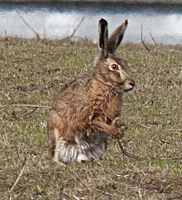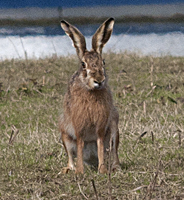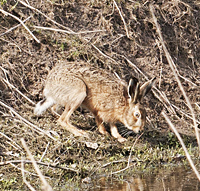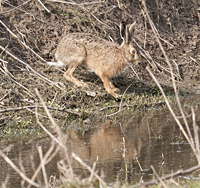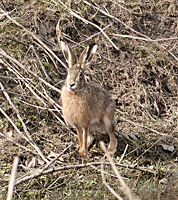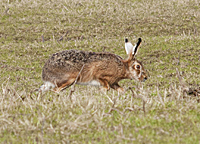The European Hare / The Brown Hare (Lepus europaeus)
European Hare has big ears and strong hind legs making it possible to run at the speed of up to 70 kms/hour.
The Brown hare is also known as European Hare and as Eastern Jackrabbit. The Brown Hare is closely related to the Rabbit. Both belong to the family Leporidae but are of a different genus. The Hare's striking features are very long black-tipped ears, black-tipped tail and large powerful hind legs. Hares are much larger than the average bunny rabbit.
Lepus europaeus is rather common in the vast area from northern and western Europe to western Asia. It is fond of tender grass shoots, including cereal plants. Therefore people dislike the presence of hares close to the cereal crops and garden plants.
Europen Hare likes open spaces in the meadows.
In spring they go crazy and they multiply like rabbits. ;) Spring is the time for "March hare madness". This is when hares fight between themelves which looks a bit like boxing match as the animals hit one another with their 'fists'. Contrary to the common belief that this is a competition between males for the best females, the fight is just involves unreceptive females fending off passionate males as a sign that they are not ready for mating yet. The breeding period is February and September and a female can produce up to three litters of 1-4 young (leverets) per year.
The natural enemies of Hares are the wolf, the fox and the birds of prey. Whole populations of hares can also be threatend by the desease called "European brown hare syndrome" (EBHS) and outbreaks of deadly epidemic diseases like tularaemia. Hares do not contract myxomatosis like rabbits do. During the last century, there has been a gradual decline in Hare numbers mostly due to modern farm machines and pesticides.
Hares are adapted to living in open habitat. These open areas make it possible for them to escape from predators by running extremely fast. In danger the Hare's speed can reach up to 70kph (45mph). Hares do not use burrows, but use a shallow depression in the ground among long grass. This nest is known as a form. Baby hares are able to look after themselves from a very early age.
An adult hare is from 2,5 to 7 kilogram and such hopping targets are popular among hunters. And when the hunters have been successful the cooks take the catch over and get creative with it in the kitchen.
Hopping merrily through the grass...
Hare is also one of the most common animals used in folklore and stories in many different cultures around the world.
In English language there are many expressions like:
- 'as mad as a March hare' = stark crazy
- 'first catch your hare, then cook him' = first things first, concentrate on one's immediate goal first
- 'if you run after two hares you will catch neither'
- 'run with the hare and hunt with the hounds' = refers to someone who wants to stay on friendly
terms with both sides in a quarrel
- ... (If you know more idioms with a hare, please email me!)

© Copyright 1998-2024 gardensafari.net (Hania Berdys)

 English / engels
English / engels  Dutch / nederlands
Dutch / nederlands